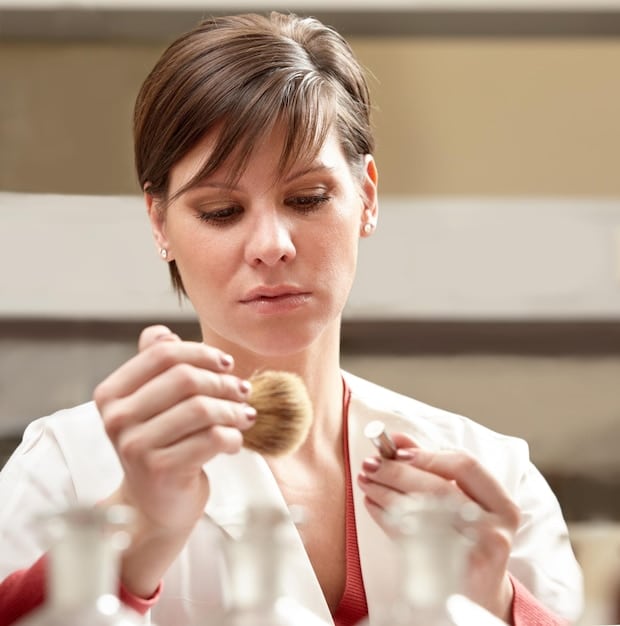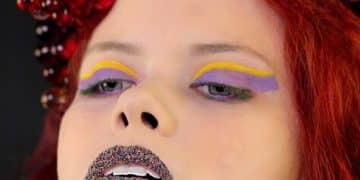Achieve a Flawless Base: Long-Wear Foundation Guide 2025

Achieving a flawless makeup base in 2025 revolves around selecting the right long-wear foundation, mastering application techniques, and understanding skincare’s role for a lasting, natural-looking finish.
Looking to achieve a perfect, long-lasting makeup base? Our 2025 guide to how to achieve a flawless base with the newest long-wear foundations will provide you with all the essential tips and techniques to master your look.
Understanding Long-Wear Foundations
Long-wear foundations are designed to stay put throughout the day, resisting sweat, oil, and transfer. Understanding their formulation and benefits is the first step to achieving a flawless base.
What Makes a Foundation Long-Wear?
Long-wear foundations typically contain polymers that create a flexible film on the skin, enhancing their staying power. They also often have oil-absorbing properties to keep shine at bay.
Benefits of Using Long-Wear Foundations
The main advantage is longevity. These foundations minimize the need for touch-ups, providing a consistent look from morning to night. They are also ideal for special events, humid weather, and oily skin types.
- Extended Wear: Lasts for 12+ hours without fading or transferring.
- Oil Control: Helps manage excess oil production, preventing shine.
- Coverage: Available in various coverage levels, from light to full.
- Resistant: Stands up to sweat, humidity, and environmental factors.
In summary, long-wear foundations deliver reliability, making them a staple in any makeup routine for those seeking lasting perfection.
Prep Your Skin for Perfection

Skincare is the groundwork for any successful makeup look. Proper preparation ensures that your foundation applies smoothly and lasts longer.
Cleanse Thoroughly
Start with a gentle cleanser to remove any dirt, oil, or makeup residue. This step creates a clean canvas for your skincare and makeup.
Hydrate and Moisturize
Even oily skin needs hydration. Apply a lightweight, non-comedogenic moisturizer to create a smooth surface and prevent foundation from clinging to dry patches.
- Exfoliate: Use a gentle scrub 1-2 times a week to remove dead skin cells.
- Tone: Balance your skin’s pH with a toner after cleansing.
- Prime: Apply a primer suitable for your skin type to create a smooth base for foundation.
Ultimately, skin preparation is essential for keeping the base flawless and improving its long lasting effect.
Choosing the Right Long-Wear Foundation
With countless options available, selecting the right long-wear foundation is crucial. Consider your skin type, desired coverage, and preferred finish to make the best choice.
Match Your Skin Type
Oily Skin: Opt for oil-free, matte formulas to control shine and prevent breakouts. Dry Skin: Look for hydrating, moisturizing formulas to avoid dryness and flakiness. Combination Skin: Choose a balanced formula that addresses both dryness and oiliness.
Consider Coverage and Finish
Light Coverage: Provides a natural look, evening out skin tone without masking imperfections. Medium Coverage: Offers more coverage while still looking natural, ideal for everyday wear. Full Coverage: Conceals blemishes, redness, and uneven skin tone, perfect for special occasions.
- Read Reviews: Check online reviews and seek recommendations from friends or makeup artists.
- Test Shades: Always test foundation shades on your jawline in natural light.
- Understand Undertones: Determine your skin’s undertone (warm, cool, or neutral) for a seamless match.
Careful consideration of these choices ensures you’ll select a foundation that enhances your natural beauty while providing lasting wear.
Application Techniques for a Flawless Finish
The way you apply your foundation can significantly impact its finish and longevity. Experiment with different methods to find what works best for you.
Tools of the Trade
Brushes: Ideal for building coverage and achieving a seamless finish. Sponges: Great for creating a natural, airbrushed look. Fingers: Can be used for light coverage and blending in small areas.
Step-by-Step Application
Start with a small amount of product and build coverage as needed. Focus on areas that need the most coverage, such as the center of the face. Blend the foundation outwards towards the hairline and jawline.
Achieving a flawless base with long-wear foundations also depends on the application process:
- Dot Method: Apply small dots of foundation across your face and blend outwards for even coverage.
- Stippling: Use a stippling brush to gently press the foundation into the skin for a natural finish.
- Blending: Spend time blending the foundation seamlessly into the skin for a natural look.
By using the right tools and techniques, you can achieve a flawless, long-lasting finish that enhances your natural beauty.
Setting and Finishing for Longevity

Setting and finishing your makeup are vital steps to ensure your foundation stays in place all day. These techniques help to lock in your look and prevent creasing.
Setting Powders
Loose Powder: Provides a soft, matte finish and helps to absorb excess oil. Pressed Powder: Convenient for touch-ups and provides a more controlled application.
Setting Sprays
Hydrating Sprays: Add moisture and prevent the makeup from looking cakey. Mattifying Sprays: Control shine and keep the makeup in place for longer.
- Baking: Apply a thick layer of loose powder to areas prone to creasing and let it sit for 5-10 minutes before dusting off.
- Blotting Papers: Use blotting papers throughout the day to absorb excess oil without disturbing your makeup.
- Finishing Touches: Apply a setting spray in a “T” and “X” formation for all-over coverage.
With the correct setting and finishing techniques, your makeup look can remain flawless for hours, increasing its appeal and resilience.
Common Mistakes to Avoid
Even with the best products and techniques, common mistakes can hinder your quest for a flawless base. Avoiding these pitfalls will ensure a perfect finish.
Over-Application
Applying too much foundation can lead to a cakey, unnatural look. Start with a small amount and build coverage as needed.
Incorrect Shade Matching
Wearing a foundation shade that is too light or too dark can make your skin look ashy or unnatural. Always test shades on your jawline in natural light.
- Skipping Skincare: Neglecting your skincare routine can result in uneven texture and poor foundation application.
- Using the Wrong Tools: Using the wrong brushes or sponges can affect the finish and longevity of your foundation.
- Forgetting to Set: Skipping setting powder and spray can cause your foundation to fade or crease.
By avoiding these common pitfalls, you can ensure your foundation looks its best and lasts throughout the day.
Long-Wear Foundation Trends in 2025
The world of makeup is ever-evolving, and long-wear foundations are no exception. Keep an eye out for these trends in 2025.
Hybrid Formulas
Combining skincare benefits with long-wear technology, these foundations offer hydration, SPF protection, and anti-aging properties.
Customizable Coverage
Foundations that allow you to customize the coverage level based on your needs, providing a natural or full coverage finish.
- Eco-Friendly Options: Sustainable packaging and cruelty-free formulas are becoming increasingly popular.
- Tech-Enhanced Application: Smart mirrors and apps that help you find the perfect shade and application technique.
- Inclusive Shade Ranges: Brands are expanding their shade ranges to cater to a wider variety of skin tones.
Staying informed about these trends will help you make the best choices for your makeup routine, ensuring a flawless base that aligns with your values and preferences.
| Key Point | Brief Description |
|---|---|
| ✨ Skin Prep | Cleanse, hydrate, and prime your skin for a smooth base. |
| 🎨 Foundation Choice | Match foundation to skin type, undertone, and desired coverage. |
| 🖌️ Application | Use brushes or sponges, building coverage where needed. |
| 🔒 Setting | Set with powder and spray for longevity and a matte finish. |
FAQ
▼
Always test the color along your jawline in natural light. The shade should seamlessly blend with your skin without a noticeable line. Consider your undertones, too!
▼
Yes, but prep is key. Use a hydrating primer and look for long-wear foundations with moisturizing ingredients. Avoid matte formulas that can accentuate dryness.
▼
Apply in thin layers and build coverage where needed. Use a damp sponge to press the foundation into the skin and set with a light dusting of powder.
▼
Use a double-cleansing method: first, an oil-based cleanser to break down the makeup, followed by a gentle cleanser to remove any residue. Be thorough to prevent clogged pores!
▼
Generally, replace your foundation every 6-12 months. Watch for changes in texture, smell, or color, as these can indicate that the product has expired and may cause irritation.
Conclusion
Mastering how to achieve a flawless base with the newest long-wear foundations in 2025 requires understanding your skin, choosing the right products, and perfecting your application technique. By keeping up with the latest trends and avoiding common mistakes, you can achieve a long-lasting, flawless look that enhances your natural beauty.





